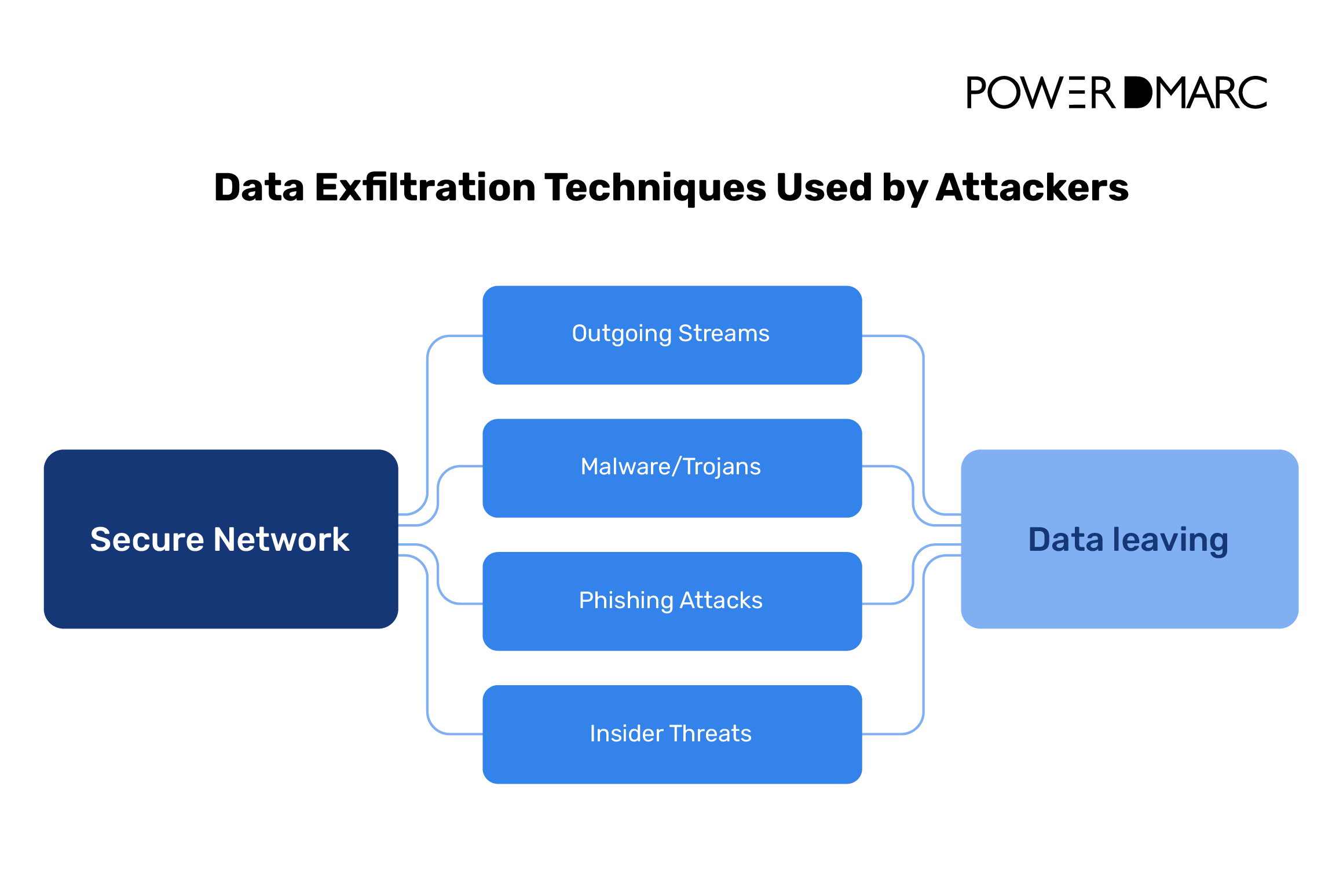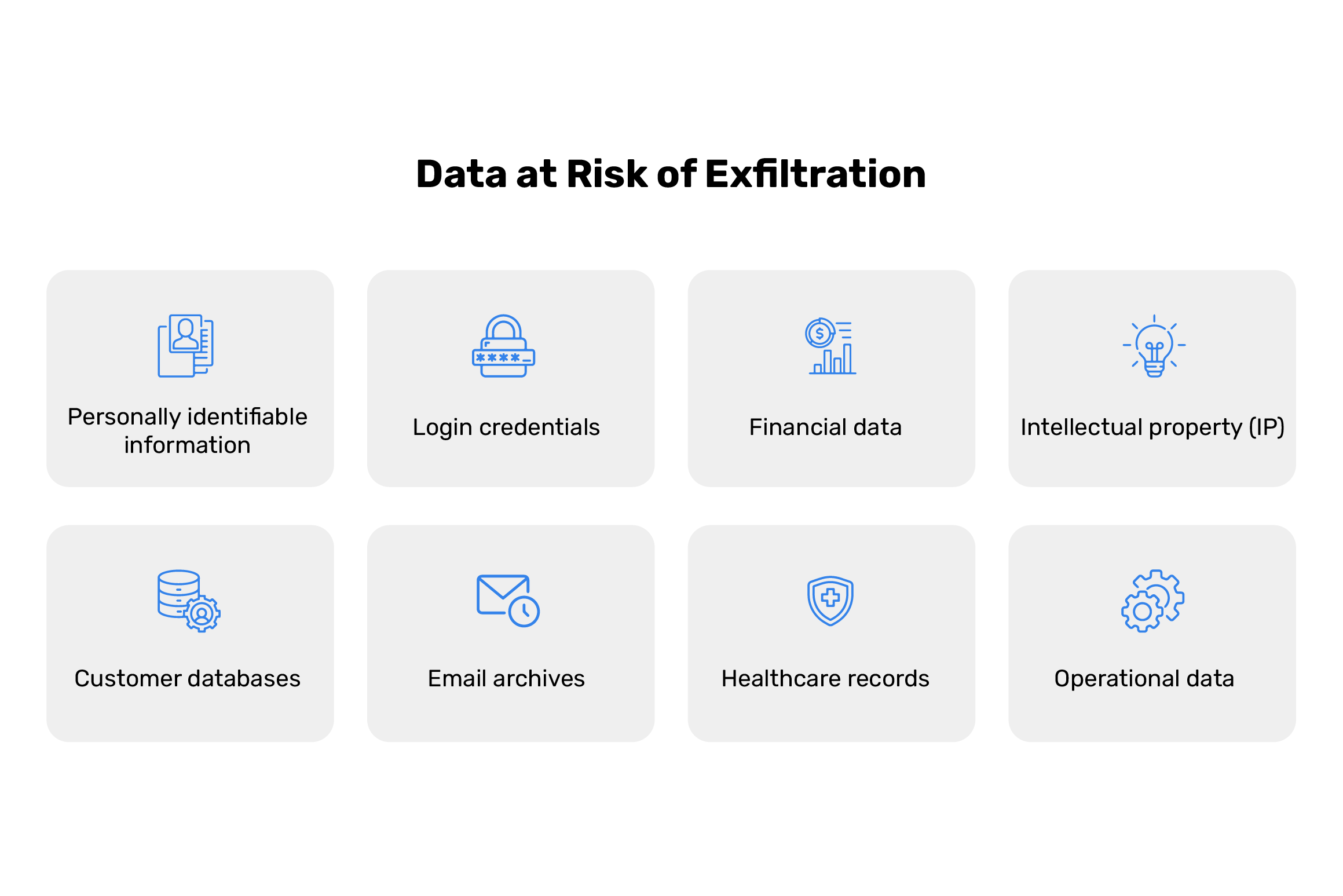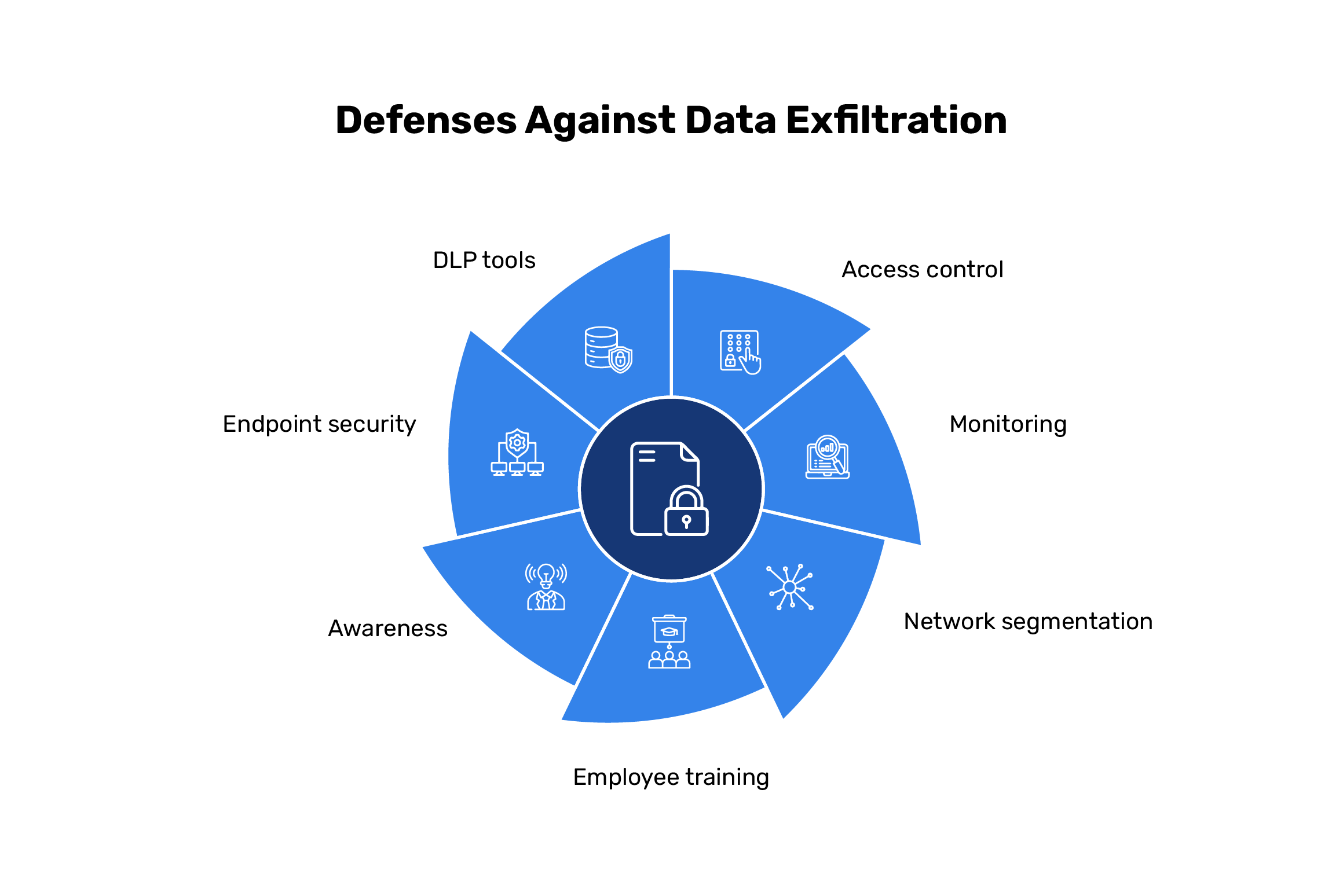Key Takeaways
- High-value data exfiltration targets include PII, financial records, intellectual property, login credentials, and customer databases.
- Attackers use methods like malware, phishing, insider misuse, and misconfigured cloud storage to steal data.
- Preventing data exfiltration requires layered defenses, including DLP tools, access controls, segmentation, endpoint security, and employee training.
In early 2022, the cybercriminal group Lapsus$ exfiltrated approximately 190 GB of internal source code and sensitive data from Samsung, including parts related to the Galaxy smartphone software and biometric authentication systems. According to Zscaler’s Annual ThreatLabz Report, incidents like this are rising fast as data exfiltration volumes jumped by 92% in the past year. It’s the kind of attack that happens quietly, with attackers slipping inside networks and removing sensitive information without leaving a trace.
For businesses, the fallout can be severe: financial losses, regulatory penalties, legal disputes, reputational harm, and the erosion of intellectual property that fuels growth. Because these breaches are often invisible until the damage surfaces, awareness has become critical. The better leaders and teams grasp what’s at stake, the better prepared they are to protect what matters most.
What Is Data Exfiltration?
Data exfiltration is a cyberattack technique that involves the unauthorized transfer of data from inside an organization to an external source. Attackers use it to move sensitive information, like intellectual property, financial records, proprietary research, or customer information, out of secure environments. They often do so without triggering any traditional security alerts.
Data exfiltration differs from normal network activity in that it primarily involves sending information out of your system rather than bringing anything in. Attackers often hide stolen data within ordinary-looking traffic, such as routine web requests or DNS lookups. The whole process can be manual, where an attacker actively searches and extracts data after breaching a system, or automated, with malware that continuously siphons information over time.
This stealth is why data exfiltration is a core tactic in Advanced Persistent Threats (APTs) and other targeted attacks. In these scenarios, attackers establish long-term access and move slowly, collecting high-value information over weeks or even months while staying under the radar.
It’s easier to understand data exfiltration when viewed in the context of other cyber threats. Data leaks tend to be accidental, often caused by simple errors such as a misconfigured database that leaves information exposed. Data breaches are broader, covering anything from stolen credentials to ransomware or system-wide disruptions. Data exfiltration is different from both because it is a calculated effort from the start.
Common Methods of Data Exfiltration
Cyber attackers adapt their techniques to exploit weaknesses wherever they find them. They even layer multiple approaches in order to bypass security tools and avoid detection.
Some of the most common methods attackers use for data exfiltration include:

Malware and trojans
Many exfiltration campaigns begin with malicious software designed to give attackers direct access to a compromised system. Remote access trojans (RATs), keyloggers, and spyware are particularly common.
A RAT allows an attacker to control an infected device as if they were physically present. It enables them to silently browse through files, copy data, install additional malicious tools, and even activate microphones or cameras without the victim’s knowledge. Keyloggers capture everything typed on a keyboard, including login credentials, while spyware runs quietly in the background and collects sensitive information over time.
What makes this method so effective is its persistence and invisibility. Once installed, these programs often operate undetected and blend into legitimate processes or hide in system files.
Phishing attacks
Phishing remains one of the most common entry points for most breaches. Attackers create and send emails that appear legitimate so as to lure recipients into either disclosing credentials or downloading malware. Once they have login details, attackers can log in as the user and exfiltrate data directly. Alternatively, phishing emails can deliver payloads like RATs or spyware, which then carry out exfiltration in the background.
A particularly dangerous variation is the so-called “spear-phishing,” in which attackers target specific individuals, for example, those with higher levels of access, like executives or IT administrators. This is often the first step in larger attacks that involve multiple methods.
Insider threats
Even employees, contractors, or other insiders with legitimate access to systems and files can pose a risk to security. In some cases, insiders may act deliberately by copying sensitive files for personal gain or out of resentment toward the organization.
However, not all insider threats are malicious in intent. It could also be unintentional, with insiders being manipulated into assisting unknowingly. For example, social engineering tactics, such as an attacker posing as IT support, can trick employees into providing credentials or transferring files under the belief that they are following legitimate instructions.
Because insiders already have valid access, their activities naturally don’t appear suspicious at first glance. Without monitoring for unusual behavior, such as accessing files outside of normal working hours or transferring large volumes of data, these actions easily slip past unnoticed.
Misconfigured cloud storage
As more businesses move to cloud platforms, misconfigured storage services have also become a common cause of data exposure. Services like Amazon S3, Google Cloud Storage, or Microsoft Azure provide flexible, scalable solutions for managing data, but misconfiguration can inadvertently expose sensitive files to anyone who knows where to look.
Attackers actively scan the internet for such mistakes. Once they find a misconfigured storage location, they can freely access and download its contents without needing to hack into the system or bypass security defenses. These incidents simply exploit human oversight and the complexity of cloud environments.
In some cases, attackers combine cloud misconfigurations with other techniques. For example, credentials stolen through phishing may be used to access a cloud account, where improperly configured permissions allow an attacker to retrieve large amounts of sensitive information in a single sweep.
Types of Data Targeted
Attackers rarely exfiltrate data at random. They tend to focus on information that holds clear value and can be exploited for further attacks or sold for profit. Understanding what they’re after can help you with prevention.

The most commonly targeted data types include:
- Personally identifiable information (PII): Names, addresses, Social Security numbers, and other details that can be used for identity theft or fraud.
- Login credentials: Usernames, passwords, session tokens, and API keys that provide direct access to systems and services.
- Financial data: Credit card numbers, banking details, transaction logs, and other payment-related information that attackers can monetize quickly.
- Intellectual property (IP): Source code, product designs, research documents, and trade secrets that give competitors or threat actors an advantage.
- Customer databases: Contact details, purchase histories, and behavioral profiles that can be resold or used in targeted scams.
- Email archives: Collections of messages that provide insight into internal operations, ideal for Business Email Compromise (BEC) or social engineering attacks.
- Healthcare records: Medical histories and insurance data that fetch high prices on illicit markets and can be exploited for fraud.
- Operational data: Internal reports, strategic documents, supplier information, and other assets that, if exposed, can disrupt operations or aid future attacks.
Signs and Indicators of Data Exfiltration
By the time the signs of data exfiltration surface, the attackers are often long gone with exactly what they came for. The longer it remains unnoticed, the greater the damage.
Being alert to early signs can make the difference between containment and a costly breach. Indicators worth close attention include:
- Unusual outbound traffic patterns or large data transfers to unfamiliar destinations
- Access to files or systems at odd hours, especially by users who don’t typically work during those times
- Anomalies in firewall or SIEM (Security Information and Event Management) logs, such as repeated failed login attempts followed by successful access
- Frequent requests for access to sensitive resources by individuals who don’t normally need them
- Use of unauthorized USB devices or file-sharing apps
- Sudden spikes in encrypted traffic leaving the network, which may signal concealed transfers
- Unexpected privilege escalations, where standard accounts suddenly gain administrative-level access
Prevention and Detection Strategies
Data exfiltration often bypasses traditional security measures. Because of this, defending against it requires a layered approach. Firewalls and antivirus alone are generally not enough. You need to combine the right technologies with strict policies and user education.
To build a strong defense against exfiltration, organizations should focus on:

Implement data loss prevention (DLP) tools
Since attackers tend to hide stolen information within legitimate-looking traffic, DLP tools can be used to inspect data as it moves through emails, endpoints, network traffic, and cloud services. Integrating DLP provides continuous visibility into how sensitive information is stored and shared.
These tools use predefined rules to recognize data such as Social Security numbers, credit card details, or source code. When a match is detected, DLP can block the transfer, quarantine the file, or alert security teams. For instance, it can stop an email with personal data from leaving the network or flag files uploaded to unauthorized cloud platforms.
By combining monitoring and enforcement, DLP makes it possible to detect and prevent some data exfiltration attempts before they cause harm.
User access control and monitoring
Limiting access is a straightforward way to reduce the risk of data exfiltration. The Principle of Least Privilege (PoLP) is a security concept that restricts users to only the permissions required for their roles. For example, if an employee’s job requires access to customer records but not financial data, their account is configured so they can only reach the customer database. This minimizes the chance of sensitive information being exposed unnecessarily.
Auditing roles and permissions on a regular basis helps identify accounts that are no longer in use or have broader access than needed. Multi-factor authentication (MFA) should also be applied to strengthen account security. It prevents attackers from using stolen credentials on their own.
Monitoring access logs is equally important. Unusual activity, such as a user connecting to a sensitive server they have never used before, can be an early sign of malicious intent.
Network segmentation
Separating networks based on function or data sensitivity creates clear boundaries that limit how far an attacker can move if they gain access. Instead of operating in a single, flat network where all systems are interconnected, segmentation breaks the environment into controlled zones.
For example, servers containing PII or proprietary research can be isolated from general employee networks. This way, even if a phishing email compromises a user’s workstation, the attacker cannot easily pivot to high-value systems without crossing additional security checkpoints.
This approach slows attackers down and forces them to trigger more alerts as they attempt to bypass segmentation controls. Each additional hurdle presented increases the chances for detection and response.
Proper segmentation also supports more granular monitoring. When high-value zones are isolated, unusual traffic patterns stand out more clearly. In turn, this allows security teams to respond faster.
Employee training and awareness
Technology alone cannot stop every attack if employees unknowingly provide an entry point. Human error remains a common factor in data breaches and phishing attacks, which is why structured training programs are needed for all. Having a security-aware workforce adds an active line of defense against data exfiltration.
Training should be centered on teaching staff how to recognize and respond to threats they encounter in their day-to-day work, like identifying phishing emails or suspicious links, knowing how and when to report unusual activity to IT teams, and following secure data handling practices.
Continuous reinforcement is key. Short, regular training sessions, combined with practical exercises, help maintain awareness and keep security top of mind. When employees understand both the risks and their role in prevention, they are far more likely to notice red flags early and thus stop an exfiltration attempt before it begins.
Endpoint security solutions
Laptops, desktops, mobile devices, and other endpoints are also frequent entry points for data exfiltration. Endpoint Detection and Response (EDR) tools, combined with next-generation antivirus, address this risk by continuously monitoring activity on individual devices. When connected to centralized monitoring systems, these tools provide a broader view of attacker behavior across the organization so that security teams can spot patterns that might go unnoticed on a single device.
Endpoint security also adds value by blocking exfiltration tools directly on devices. If malware attempts to create encrypted channels or manipulate system processes to disguise stolen data, EDR can intervene immediately. This device-level defense, paired with network monitoring, forms a layered approach that makes it significantly harder for attackers to move data out of the organization undetected.
The Bottom Line
Data exfiltration adds to the growing list of cyber threats demanding proactive defense. Preventing it starts with closing off the routes attackers use to access and remove sensitive data, making it harder for them to operate undetected.
PowerDMARC supports this effort with advanced authentication protocols, monitoring tools, and real-time threat intelligence that strengthen defenses for email, one of the most frequent entry points for attackers. By securing this critical channel, organizations can reduce the risk of phishing-driven breaches and keep sensitive data from slipping out of reach.
Cybercriminals rely on stealth and persistence, but you don’t need to leave the door open for them. Book a demo with us, and you can turn one of your greatest vulnerabilities into a line of protection.
Frequently Asked Questions (FAQs)
What is the difference between data exfiltration and data leakage?
Data exfiltration is the intentional and unauthorized transfer or theft of data, while data leakage is the unintentional or accidental exposure of sensitive data.
What industries are most at risk of data exfiltration?
Industries handling valuable or sensitive information, like finance, healthcare, technology, government, and manufacturing, tend to be most at risk.
What regulations address data exfiltration risks?
Key regulations include GDPR (General Data Protection Regulation), HIPAA (Health Insurance Portability and Accountability Act), and PCI DSS (Payment Card Industry Data Security Standard), all of which impose strict standards for safeguarding sensitive data.

- What Is Data Exfiltration? Detection and Prevention - August 7, 2025
- What Is an Advanced Persistent Threat? APT Explained - August 5, 2025
- What is SOC 2? Types, Trust Criteria & Process - July 31, 2025


